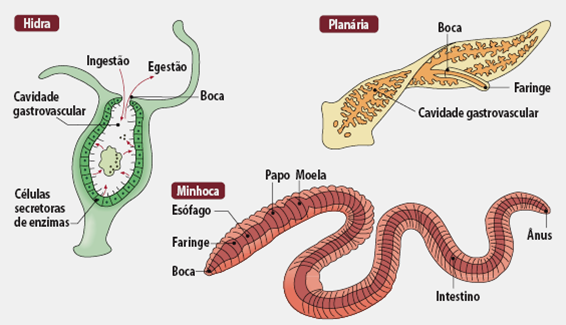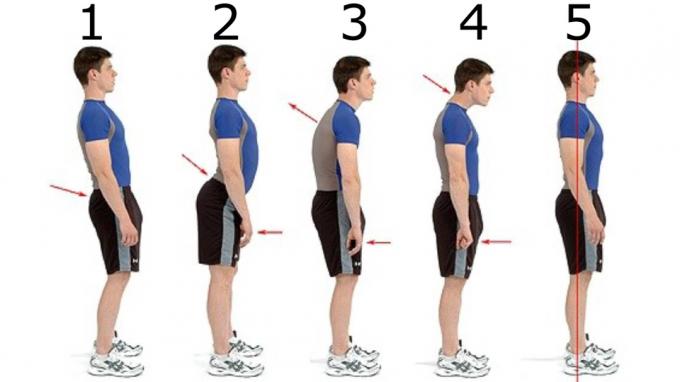Nutrition is the ability of organisms to obtain raw materials from their habitat to build their bodies and carry out their metabolic activities. The vast majority of animals are heterotrophic by ingestion, that is, they break down organic molecules complex molecules into simple molecules within the organism, because only in this form can they penetrate the membrane of the cells. This breakdown of molecules is a process known as digestion, it occurs in the presence of water and digestive enzymes, hence we say that digestion is an enzymatic hydrolysis of food.
digestion in invertebrates
see more
Biology teacher fired after class on XX and XY chromosomes;…
Cannabidiol found in common plant in Brazil brings new perspective…
In sponges, digestion takes place entirely inside the cell, this type of digestion is called intracellular digestion. Only microscopic organisms can serve as food for sponges, as this is the only way choanocytes (cells responsible for the digestion of these animals) manage to use these organisms as foods.
In cnidarians and flatworms there is both intracellular digestion and extracellular digestion, which occurs inside a digestive cavity. In these animals, the digestive cavity has only one opening, the mouth, we say that this type of digestive tract is incomplete. the others invertebrates they have a complete digestive tract, with two openings: the mouth and the anus. Normally, animals that have a complete digestive tract, begin to have only extracellular digestion and begin to folds appear in this digestive tract, which are capable of secreting digestive enzymes, thus forming glands digestive.

digestion in vertebrates
The types of dentition vary according to the eating habits of mammals: rodent animals, such as rabbits, have well-developed incisor teeth; carnivorous animals, such as dogs, have canine teeth forming fangs; animals with herbivorous habits, such as the ox and the horse, have more developed molar teeth than the others.
All fish have the same teeth and some, such as the shark, have not just one row of teeth, but several. Amphibians do not always have teeth, and those that do have are just prehensile teeth. Venomous snakes can have two special teeth, which will turn into fangs that squirt venom. In turtles, teeth look like blades that serve to crush food.
The birds have a horny beak and no teeth. Many of them have a dilation in the esophagus that is called the crop, it is there that the grains are stored and softened before being taken to the stomach. The stomach of birds is divided into chemical or proventriculus (produces digestive enzymes) and gizzard or mechanical stomach (thick walls of muscle that grind food).
In ruminants (such as ox, sheep and camel, for example) there are four stomachs: the belly or rumen, the cap, the leaf and the coagulator. After being chewed a few times, the food falls into the belly and cellulose is digested, few animals are able to digest this polysaccharide, humans are not able to digest cellulose. Cellulose digestion begins with the breakdown of this polysaccharide by the cellulase enzyme, then digestion is carried out by bacteria and protozoa. The food goes to the cap that throws it back to the mouth, where it is chewed a second time. After the second swallow, the food goes to the leafy plant, which is responsible for absorbing the water and grinding the food. Finally, the food reaches the coagulator, which is responsible for the production of digestive enzymes.
In herbivorous animals, the intestine is larger than in carnivorous animals, including humans. This is because the difficulty of digesting cellulose is much greater than the difficulty of digesting food of animal origin. In many vertebrates (cartilaginous fish, amphibians, birds, etc.) the digestive, urinary and reproductive systems end in an opening called the cloaca.

human digestion
In humans, digestion begins in the mouth. At first, the food is crushed and mixed with saliva, where it undergoes the action of the ptyalin enzyme or salivary amylase, which is produced in the salivary glands, through this enzyme, the breakdown of starch molecules into maltose. This enzyme only acts in the neutral pH of the mouth, it is inhibited in the acid pH of the stomach, hence the importance of chewing food well. After swallowing, the food is pushed by peristaltic movements from the esophagus to the stomach, where it is mixed with gastric juice which contains hydrochloric acid (HCl) to facilitate the action enzymatic. The main enzyme of this human gastric juice is pepsin, it is produced in an inactive form called pepsinogen, which begins the breakdown of proteins, turning them into small fragments called peptides.
For the organism to produce gastric juice, it needs nervous stimuli. After the action of the enzymes, the processed food is turned into a paste called chyme. The chyme is taken to the small intestine (duodenum, jejunum and ileum), which produces secretin and cholecystokinin hormones that will act on the pancreas and gallbladder, causing these organs to release pancreatic juice and bile into the duodenum, respectively.
Pancreatic juice is quite alkaline, it is composed of: trypsin and chymotrypsin (they break down proteins and peptides), pancreatic amylase (ends breaking down starches that salivary amylase started), lipase (digests lipids), carboxypeptidase (breaks more peptide bonds), nucleases (digests nucleic acids). Bile is produced in the liver and is stored in the gallbladder and released into the intestines. Bile has bile salts in its composition that act as diluents, which emulsify fats, that is, transform fats into small droplets that join the water, this causes the contact surface of the lipids with the lipase to be increased, facilitating the breakdown of this substance.
Human digestion is a long process and only ends in the small intestine, with the intestinal juice produced by this organ. This intestinal juice is composed of:
- maltase (hydrolyzes maltose into glucose)
- sucrase (breaks sucrose into glucose and fructose)
- lactase (breaks down lactose into glucose and galactose)
- aminopeptidases
- dipeptidases and tripeptidases (hydrolyze peptides)
- lipase (turns fats into fatty acids and glycerol)
After digestion, food turns into a white liquid called chyle. The simple molecules that are present in the chyle are absorbed by the wall of the intestine and released into the bloodstream. The intestine is full of folds and villi that increase the surface area for these nutrients to be absorbed. In the large intestine, the rest of the water is absorbed and the waste accumulates and forms the fecal cake that will be eliminated through the anus.

Denisele Neuza Aline Flores Borges
Biologist and Master in Botany

